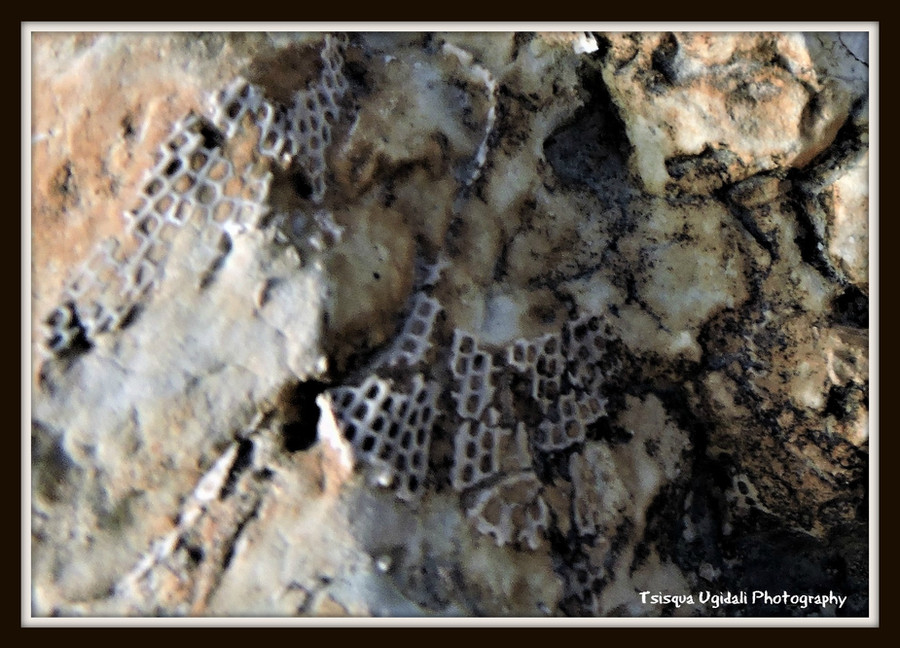HOME | DD
 Tsisqua-Ugidali — Bryozoan fossils
Tsisqua-Ugidali — Bryozoan fossils

#bryozoans #history #pennsylvanian #permian #rocks #netlike #animals #colonial #colony #fossil #geology #naturephotography
Published: 2017-01-20 12:16:32 +0000 UTC; Views: 396; Favourites: 5; Downloads: 0
Redirect to original
Description
Description: Bryozoans are some of the most abundant fossils in the world. They are also widespread today, both in marine and freshwater environments, living at all latitudes and at depths ranging downward to at least 27,900 feet (8,500 meters).Marine bryozoans show up in the fossil record in the early part of the Ordovician Period, about 470 million years ago. In Kansas, fossil bryozoans are common in the Pennsylvanian and Permian rocks of the eastern part of the state.
Bryozoan fossils from the Topeka Limestone in Kansas. These fossils were deposited during the Pennsylvanian Period, about 300 million years ago, and illustrate the branching and netlike forms of some bryozoan colonies.
Freshwater bryozoans are virtually unknown as fossils, presumably because they did not have mineralized skeletons. Throughout their nearly 500-million-year history, marine bryozoans have been abundant and widely distributed geographically. They are the most abundant fossils in many limestones, calcareous shales, and mudstones. At least 3,500 living species and 15,000 fossil species are known.
Bryozoans are small animals (just large enough to be seen with the naked eye) that live exclusively in colonies. In fact, the Phylum Bryozoa is the only animal phylum in which all known species form colonies. The name comes from two Greek words, bryon (moss) and zoon (animal), and bryozoans are sometimes called moss animals because some colonies resemble mosses.
Bryozoans are sometimes confused with corals, another colonial group of animals. Like corals, most bryozoans secrete external skeletons made of calcium carbonate, which form the framework of the colony. Bryozoans, however, are more complex organisms than corals and generally don't build reefs.
Individual members of a bryozoan colony are called zooids. Although all zooids in the colony are physically connected, each lives in its own calcium carbonate compartment. Some or all zooids in a colony are feeding zooids, equipped with tentacle-bearing feeding organs. Bryozoans feed by projecting these tentacles into the water through openings in their external skeletons (see drawing below). The tentacles have tiny moving filaments called cilia, which create currents that draw microscopic organisms and plants into the mouth. Feeding zooids also have an alimentary canal, muscles, a nervous system and a U-shaped digestive tract. Simple egg- and sperm-producing structures are also present in some zooids in every colony.
Fenestella, another bryozoan found in Kansas rocks, is one of the bryozoans whose colonies had a netlike structure. This fossil genus is also known from the Mississippian to the Permian (drawings by Al Kamb, KU Natural History Museum, Invertebrate Paleontology).
Bryozoan fossils turn up frequently in the Pennsylvanian and Permian rocks of eastern Kansas. The Florena Shale in Riley and Pottawatomie counties is an excellent place to find bryozoans, and they are also common in the Plattsmouth Limestone Member (of the Oread Limestone), the Beil Limestone Member (of the Lecompton Limestone), and the Topeka Limestone. Bryozoans are less common in the Cretaceous rocks to the west.
Stratigraphic Range: Lower Ordovician to Holocene.
Taxonomic Classification: Bryozoans belong to Kingdom Animalia, Phylum Bryozoa. The phylum is divided into three classes, the Phylactolaemata (freshwater bryozoans), the Stenolaemata, and Gymnolaemata.
Related content
Comments: 10

Yes I did, in Kansas no less.
👍: 0 ⏩: 1

Cool! I have never once found a fossil but not for lack of trying. We just don't have them around here. :/
👍: 0 ⏩: 1

I have plenty. I would be happy to send you one if you would like one. Send me your address via Notes (I will keep safe and secure), and you will receive one in the mail. I've had others who want them too.
👍: 0 ⏩: 1

That is amazingly generous! Have you considered selling them on Etsy?
👍: 0 ⏩: 1

No, until you showed me the page, I didn't have a understanding of it. I wouldn't even know how to do such a thing. I am basically a collector, but a little extra money wouldn't hurt. Although, I have no clue what to even sell them for. Let me think about it.
👍: 0 ⏩: 1

If you are interested and need some help getting started let me know. As for pricing... Google items such as yours as if you were comparison shopping. Google, Amazon.com, eBay are all great places for this.
👍: 0 ⏩: 1

I will check them out.
👍: 0 ⏩: 0

fantastic description, learned something about Kansas and Bryozoan's!
👍: 0 ⏩: 1

Send me your address via email at appyrider77@yahoo.com
I will send my address only that way. I will exchange and send you some fossils.
👍: 0 ⏩: 0
























